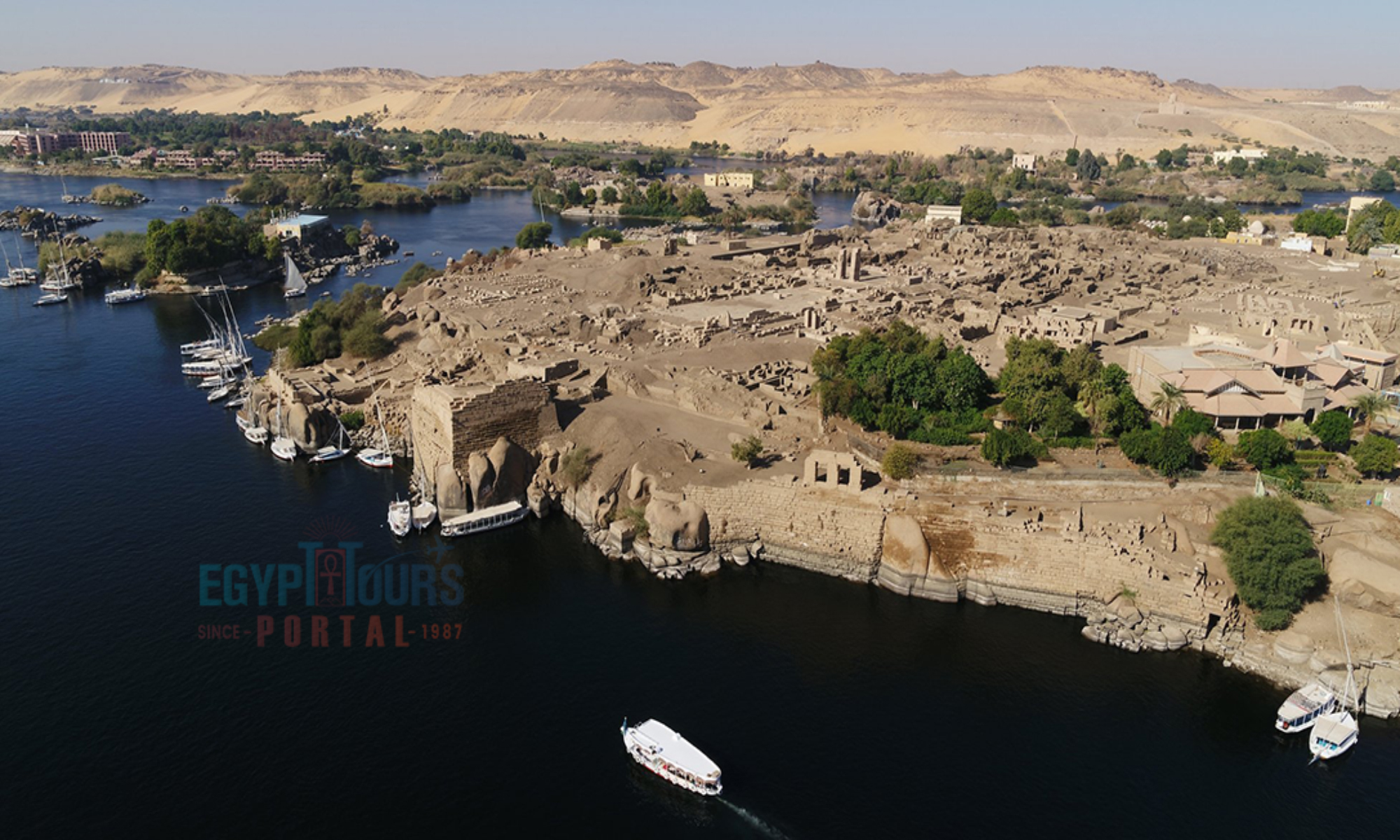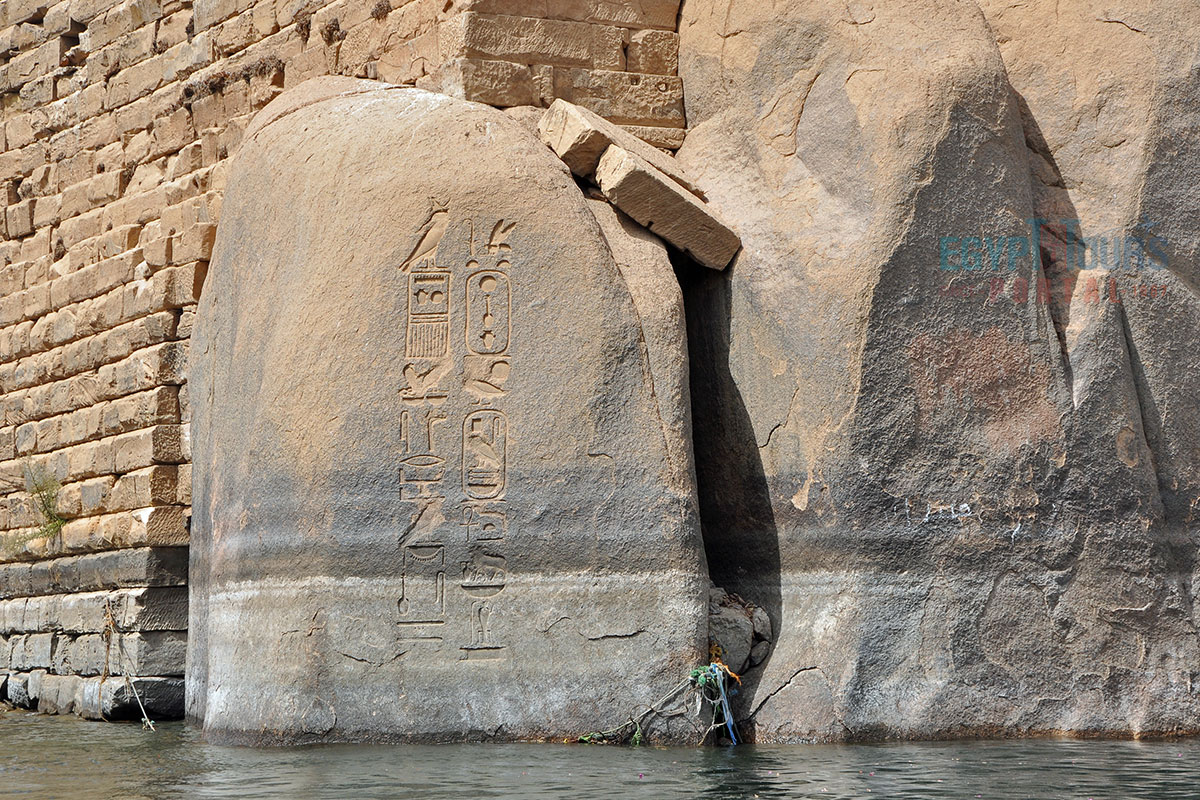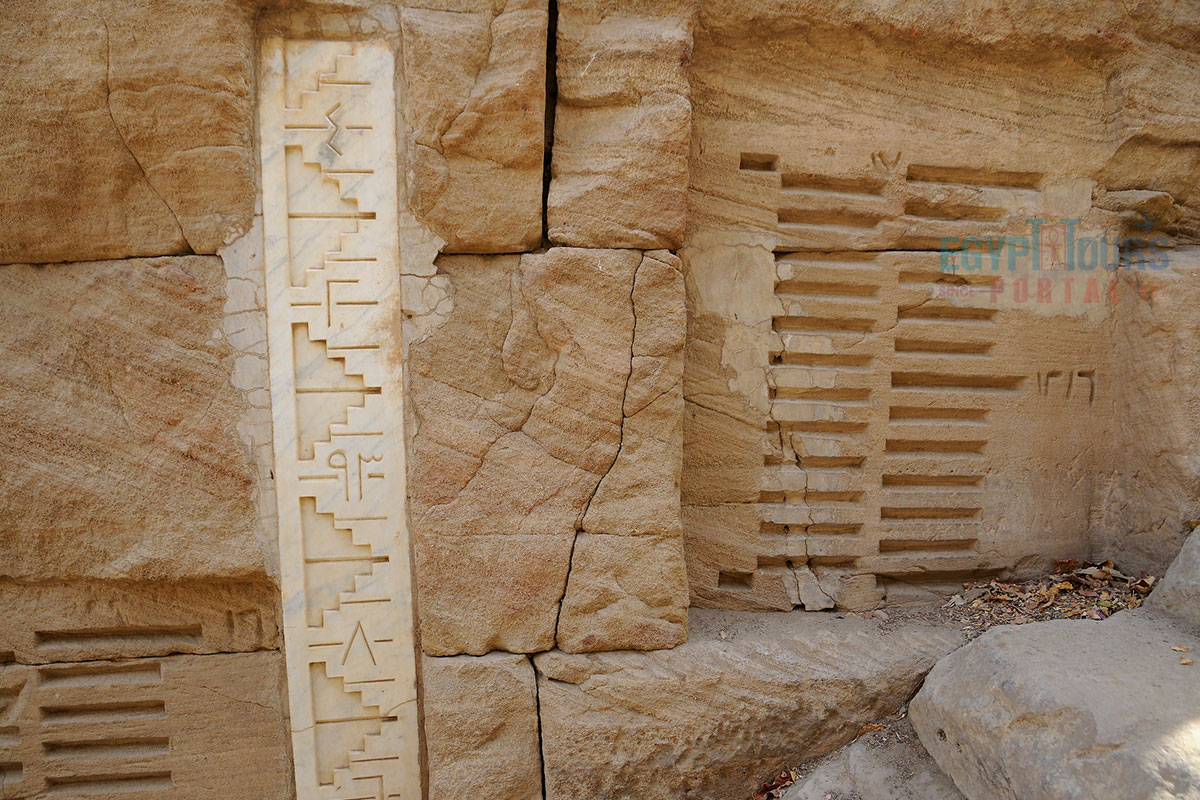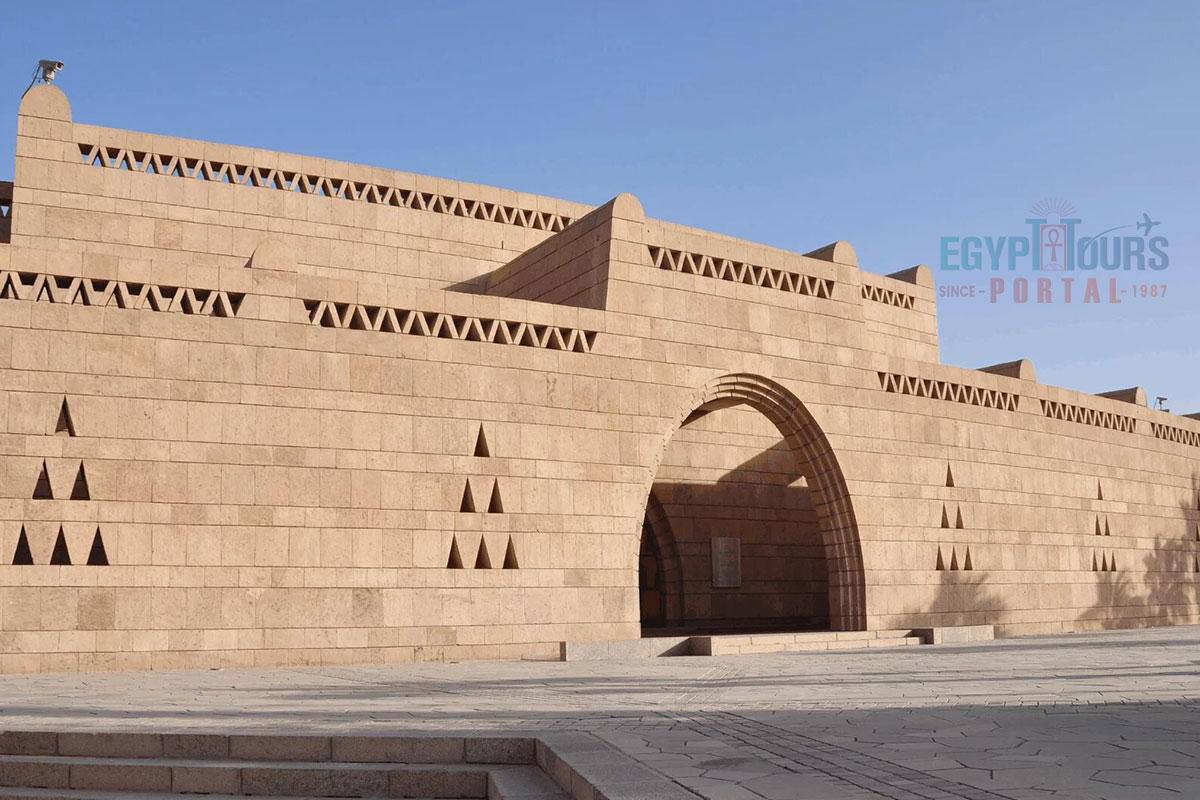Elephantine Island, located in the Nile at Aswan, is a 5,000-year-old archaeological site that played a crucial role in Egypt’s architectural development. It housed temples dedicated to Khnum and Satet, with remnants still standing today. The island also features Nilometers for measuring the Nile’s water levels and the Aswan Museum, showcasing artifacts like the mummified ram of Khnum. Ongoing excavations continue to uncover its rich history. Now a UNESCO World Heritage Site, Elephantine Island remains a significant link to Egypt’s ancient past.

Elephantine Island is a golden gem found in the deep heart of southern Egypt in Aswan, which has been protected by the ethereal spirit of the Nile River for thousands of years. Elephantine Island has impacted the construction evolution of this immortal civilization of ancient Egypt, as it served as an important stone quarry center that supplied granite for monuments and buildings throughout the history of Egypt. The island is famous for containing several magnificent archaeological marvels, which in 1979 became part of the UNESCO World Heritage Sites. This attraction has a long history and several immortal wonders that have magnificent stories to tell of great gods and kings.

Elephantine is a magnificent island located in Aswan that has a length of 1,200 meters (3900 ft) from north to southern side plus a width of 400 meters (1300 ft). This island is situated exactly at the First Cataract downstream, found between Upper Egypt and Lower Nubia at the deep southern border. It gained its name from its distinctive shape, which resembles a massive elephant tusk when viewed from above, or the presence of huge rocks along its banks that resemble elephant tusk, which is known as ivory. The layout of Elephantine and nearby islands can be observed perfectly from the hillsides on the west bank of the Nile.

Elephantine was famous as "ꜣbw" in ancient Egypt, an island at the southern border between Nubia and Upper Egypt. It served as a strategic location for a city due to its defensibility and its role as a natural point for transferring goods across the Nile River, which was a gigantic trade center. This border is close to the Tropic of Cancer, marking the northernmost latitude where the sun could be directly overhead at the time of noon, where it appears to turn back at the solstices.
During the Second Intermediate Period (1650–1550 BC), Elephantine's fort marked Egypt's southern boundary. Some historical texts from the Middle Kingdom of Egypt (2040 - 1782 BC) mentioned that the mother of Amenemhat I, "the founder of the 12th Dynasty," hailed from the Elephantine Egyptian nome known as Ta-Seti, leading some scholars to suggest the mother has Nubian origins. Elephantine was associated with one of the oldest ancient Egyptian deities, Khnum, who was the ram-headed deity of the Nile cataracts, who was believed to live and dwell beneath the island where he controlled the Nile's waters.
Khnum was part of the "Elephantine Triad," which included Satis and Anuket. Satis was known as a war goddess who protected this Egyptian strategic region and later represented the annual Nile flooding, with Anuket identified as their daughter. The cult of Satis is known to have originated in Aswan, and Khnum was considered her consort, who was later associated with pottery and the creation of the bodies of humans.

Before 1822, Elephantine Island in Egypt housed temples dedicated to the pharaohs, Amenhotep III and Thutmose III, which Muhammad Ali destroyed during his campaign to conquer Sudan after he took charge of Egypt. These temples were at some point intact before their deliberate demolition. The Temple of Satet, which was created in 3000 BC, was one of the earliest structures on the island and underwent expansion and renovation over thousands of years. Several historical records indicate the presence of an ancient Egyptian temple dedicated to the god Khnum on the island as far back as the 3rd Dynasty.
This marvelous temple underwent complete reconstruction during the 13th Dynasty, before the early days of the Graeco-Roman age of Egypt. During the Ptolemaic dynasty (305–30 BC), the ancient Greeks maintained the island's ancient religious traditions and customs, which revolved around their ancient Egyptian gods and goddesses. The Island's southern tip is mostly occupied by the marvelous remains and ruins of the magnificent Khnum Temple, which include a step pyramid made of granite that originated in the 3rd Dynasty and a marvelous small temple for the 6th Dynasty nomarch known as Heqaib. Various officials and local governors have several dedicated shrines and statues within this temple.

Nilometers were structures that were used to measure the water level and clarity of the Nile River during the annual flood season. Elephantine Island is known to have two kilometers. The most famous of the two is an epic corridor nilometer which is linked to the phenomenal Temple of Satis, which has a majestic stone staircase descending the corridor and is among Egypt's oldest nilometers, last renovated during the Roman ages and used until the 19th century AD. This nilometer has ninety steps marked with hieroglyphic, Roman, and Arabic numerals, which lead down to the river.
Inscriptions from the 17th Dynasty can be seen at the water's edge. The other nilometer is by far the older of the two, which has the shape of a rectangular basin found at the island's southern tip, close to the magnificent Temple of Khnum. It's worth noting that the renowned "Well of Eratosthenes," which is often associated with Eratosthenes' calculation of the Earth's circumference, is sometimes linked to Elephantine Island.
However, historical sources, including the Greek historian Strabo, mention a well in Aswan, not on Elephantine Island, which was utilized to observe Aswan's location that is found on the Tropic of Cancer. Neither of the nilometers on Elephantine Island was suitable for the purpose attributed to the "Well of Eratosthenes" and the well of Aswan mentioned by Strabo is considered forever lost.

The Aswan Museum can be found at the southern tip of the island, which displays archaeological discoveries that include a mummified ram of Khnum. The island's central area hosts three Nubian villages, and a lavish hotel is found at the northern tip. Also, the Aswan Botanical Garden is found next to el Nabatat Island on the western side. Ongoing excavations by the German Archaeological Institute have yielded numerous artifacts, including a mummified ram of Khnum, displayed in the Aswan Museum on the island. The island has also yielded prehistoric Egyptian artifacts and a unique calendar known as the Elephantine Calendar of Things, dating to the reign of Thutmose III during the Eighteenth Dynasty.
Elephantine Island is filled with several priceless archaeological milestones that date back thousands of years, which can provide some of the most miraculous tales about celestial figures. The location where the Island is found is at the heart of southern Egypt on the Nile River, where the miraculous wealth of this golden civilization will come to life in front of your eyes. Through our amazing Egypt Tours and magnificent nile river cruises, everyone will come to cast their eyes on all the marvelous treasures found in Aswan.
Day Trip to Abu Simbel from Aswan For Australian Travelers Day Trip to Abu Simbel fr...
Tour Location: Abu Simbel...
Aswan Sightseeing Tour for Australian Travelers Aswan Sightseeing Tour will be an en...
Tour Location: Aswan...
Day Trip from Aswan to Edfu & Kom Ombo Temples for Australian Travelers Day Trip...
Tour Location: Edfu/Kom Ombo...
Day Trip from Aswan to Cairo by Plane for Australian Travelers Day Trip from Aswan t...
Tour Location: Cairo/Giza...
The entire country of Egypt deserve to be explored with its every heavenly detail but there are places that must be seen before any other such as the breathtaking Hurghada's red sea, The wonders of Cairo the pyramids of Giza, the great sphinx, the Egyptian Museum, Khan El Khalili Bazaar, the wonders of Luxor like Valley of the Kings, Karnak & Hatshepsut temple and the wonders of Aswan such as Abu Simbel temples, Philea temple, Unfinished obelisk and The Wonders of Alexandria like Qaitbat Citadel, Pompey's Pillar and Alexandria Library. Read more about the best places to visit in Egypt.
If you want to apply for a Visa On Arrival that lasts for 30 days then you should be one of the eligible countries, have a valid passport with at least 6 months remaining and pay 25$ USD in cash, as for the E-Visa for 30 day you should have a valid passport for at least 8 months, complete the online application, pay the e-visa fee then print the e-visa to later be presented to the airport border guard. You could also be one of the lucky ones who can obtain a free visa for 90 days. Read more about Egypt travel visa.
Egypt has a variety of delicious cuisines but we recommend “Ful & Ta’meya (Fava Beans and Falafel)”, Mulukhiya, “Koshary”, a traditional Egyptian pasta dish, and Kebab & Kofta, the Egyptian traditional meat dish.
The best time to travel to Egypt is during the winter from September to April as the climate becomes a little tropical accompanied by a magical atmosphere of warm weather with a winter breeze. You will be notified in the week of your trip if the Climate is unsafe and if any changes have been made.
You should pack everything you could ever need in a small bag so you could move easily between your destinations.
We have been creating the finest vacations for more than 20 years around the most majestic destinations in Egypt. Our staff consists of the best operators, guides and drivers who dedicate all of their time & effort to make you have the perfect vacation. All of our tours are customized by Travel, Financial & Time consultants to fit your every possible need during your vacation. It doesn't go without saying that your safety and comfort are our main priority and all of our resources will be directed to provide the finest atmosphere until you return home.
You will feel safe in Egypt as the current atmosphere of the country is quite peaceful after the government took powerful measures like restructuring the entire tourist police to include all the important and tourist attractions in Egypt. Read more about is it safe to travel to Egypt.
Wear whatever feels right and comfortable. It is advised to wear something light and comfortable footwear like a closed-toe shoe to sustain the terrain of Egypt. Put on sun block during your time in Egypt in the summer to protect yourself from the sun.
The best activity is by far boarding a Nile Cruise between Luxor and Aswan or Vise Versa. Witness the beauty of Egypt from a hot balloon or a plane and try all the delicious Egyptian cuisines and drinks plus shopping in old Cairo. Explore the allure and wonders of the red sea in the magical city resorts of Egypt like Hurghada and many more by diving and snorkeling in the marine life or Hurghada. Behold the mesmerizing western desert by a safari trip under the heavenly Egyptian skies.
There are a lot of public holidays in Egypt too many to count either religious or nation, the most important festivals are the holy month of Ramadan which ends with Eid Al Fitr, Christmas and new years eve. Read more about festivals & publich holidays in Egypt.
Egypt is considered to be one of the most liberal Islamic countries but it has become a little bit conservative in the last couple of decades so it is advised to avoid showing your chest, shoulders or legs below the knees.
Arabic is the official language and Most Egyptians, who live in the cities, speak or understand English or at least some English words or phrases. Fewer Egyptians can speak French, Italian, Spanish, and German. Professional tour guides, who work in the tourism sector, are equipped to handle visitors who cannot speak Arabic and they will speak enough English and other languages to fulfill the needs of all our clients.
The fastest way is a car, of course, a taxi. If you are in Cairo ride a white taxi to move faster or you could board the fastest way of transportation in Egypt metro if the roads are in rush hour.
The temperature in Egypt ranges from 37c to 14 c. Summer in Egypt is somehow hot but sometimes it becomes cold at night and winter is cool and mild. The average of low temperatures vary from 9.5 °C in the wintertime to 23 °C in the summertime and the average high temperatures vary from 17 °C in the wintertime to 32 °C in the summertime. The temperature is moderate all along the coasts.
It is the home of everything a traveler might be looking for from amazing historical sites dating to more than 4000 years to enchanting city resorts & beaches. You will live the vacation you deserve as Egypt has everything you could possibly imagine.









